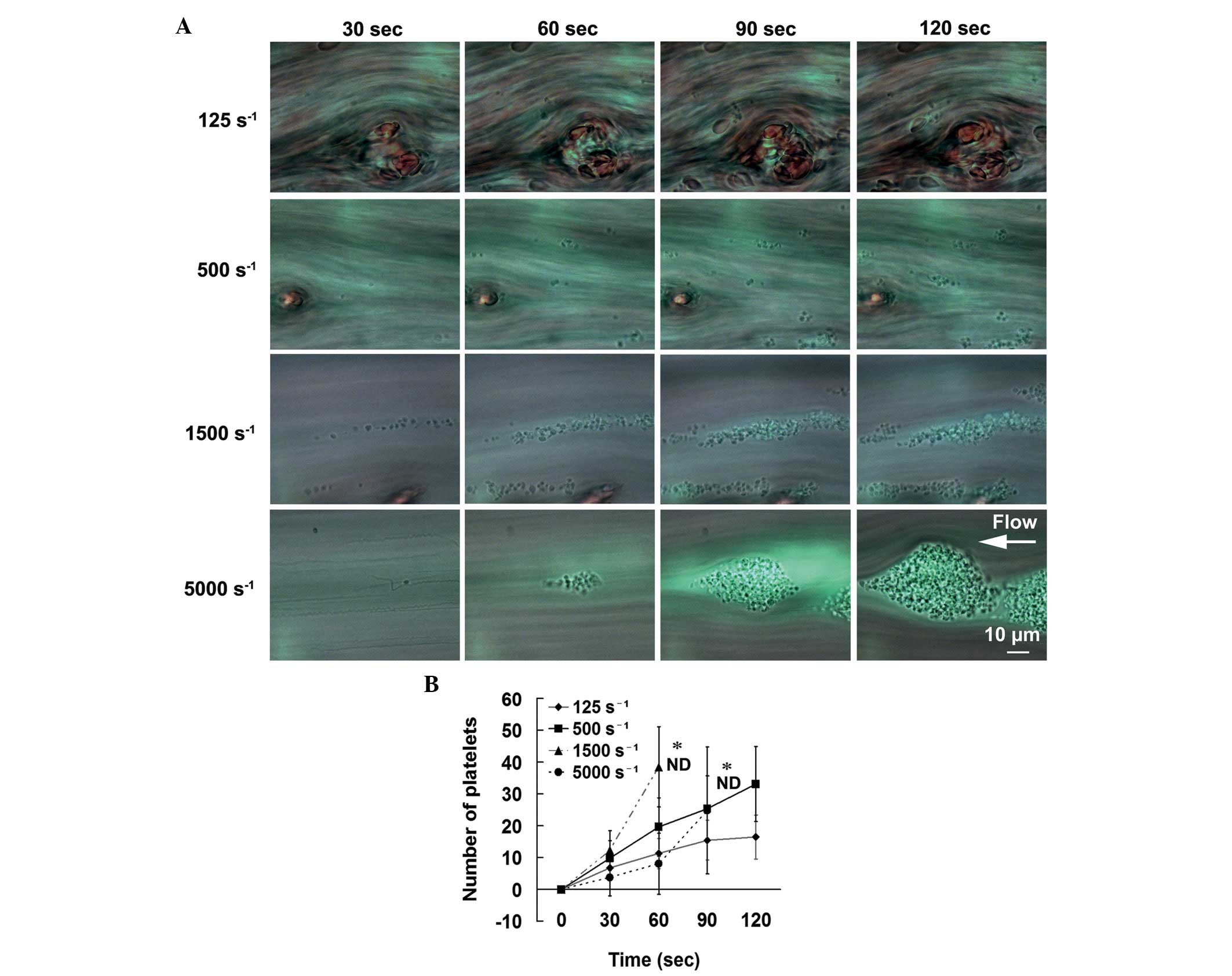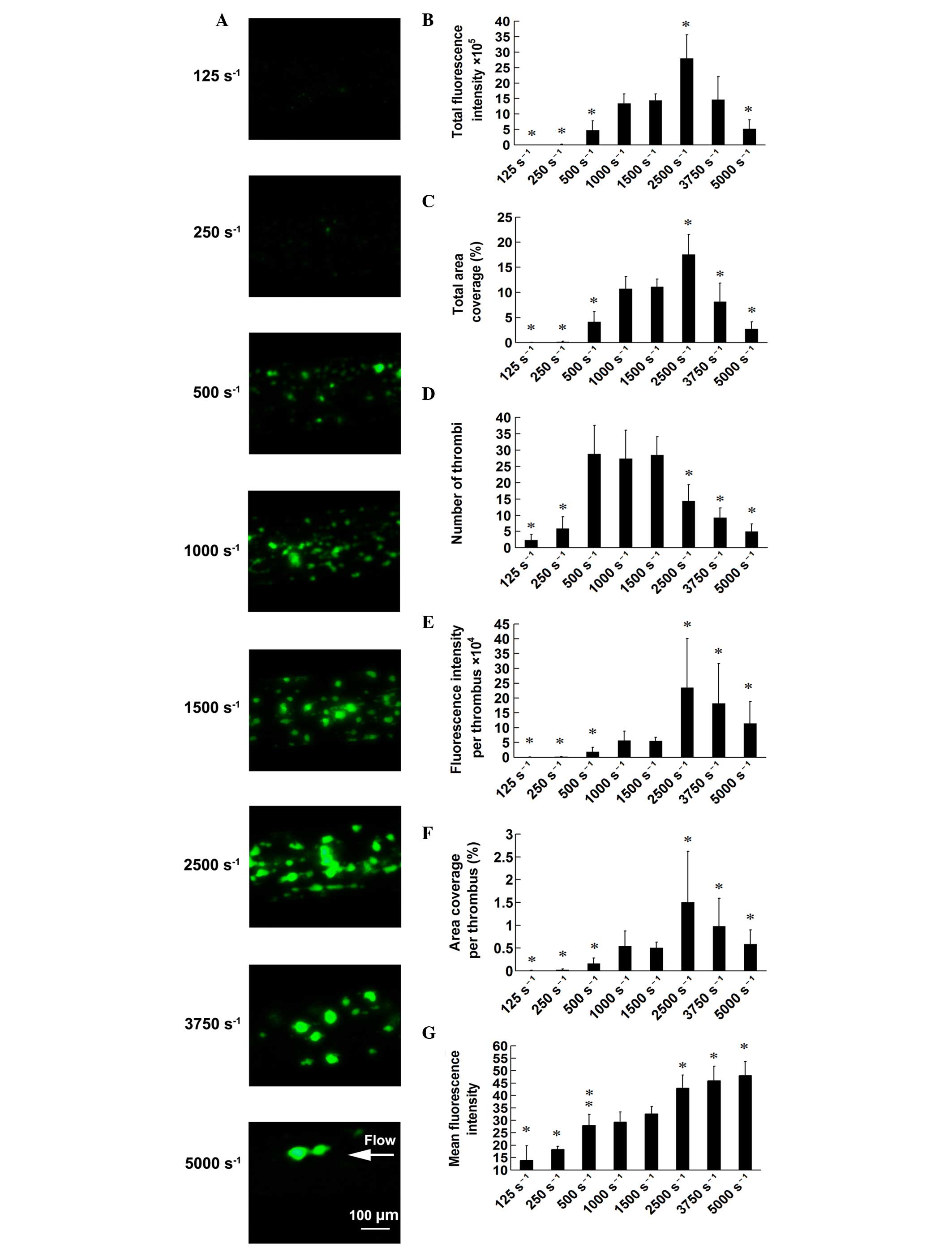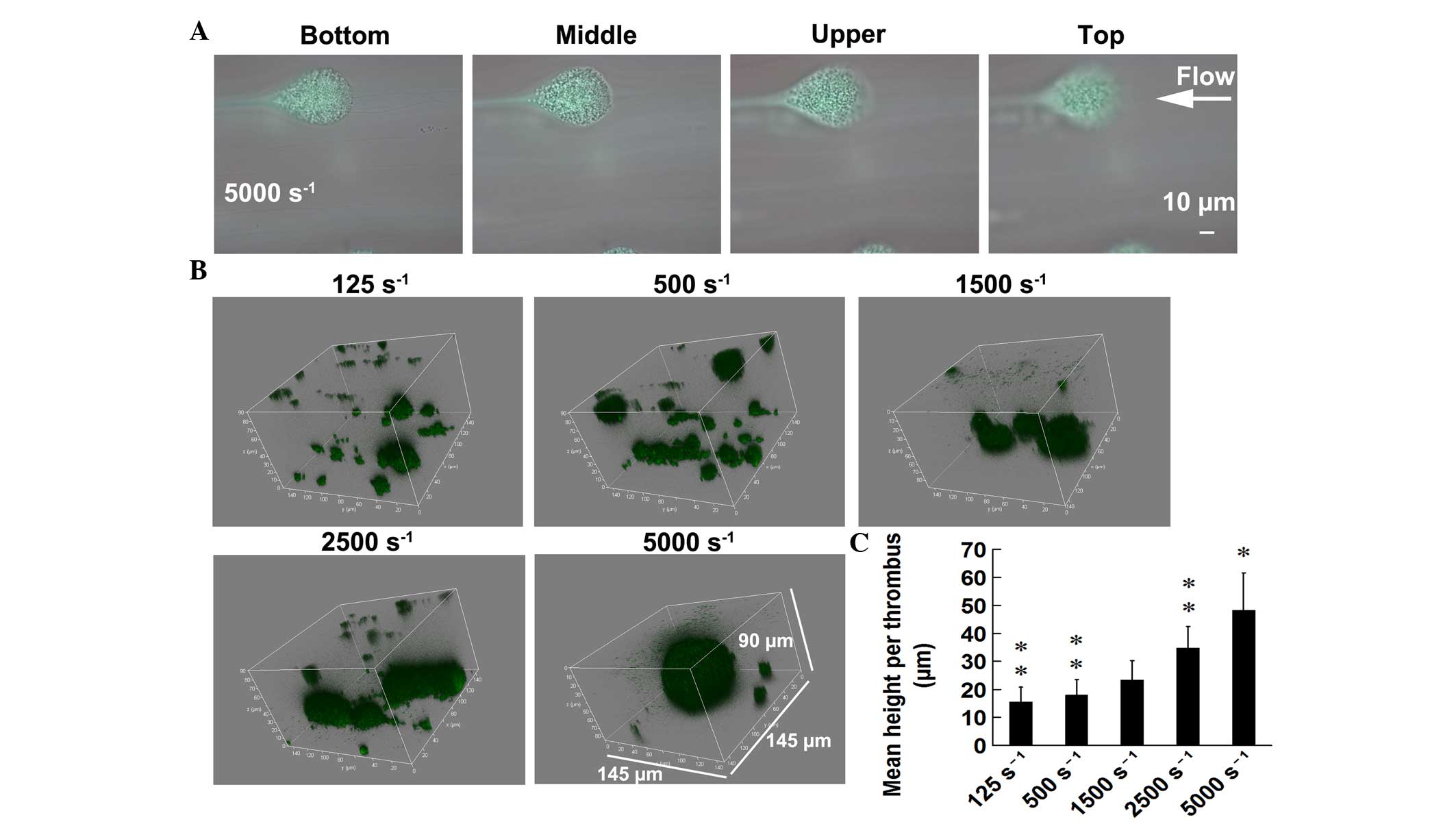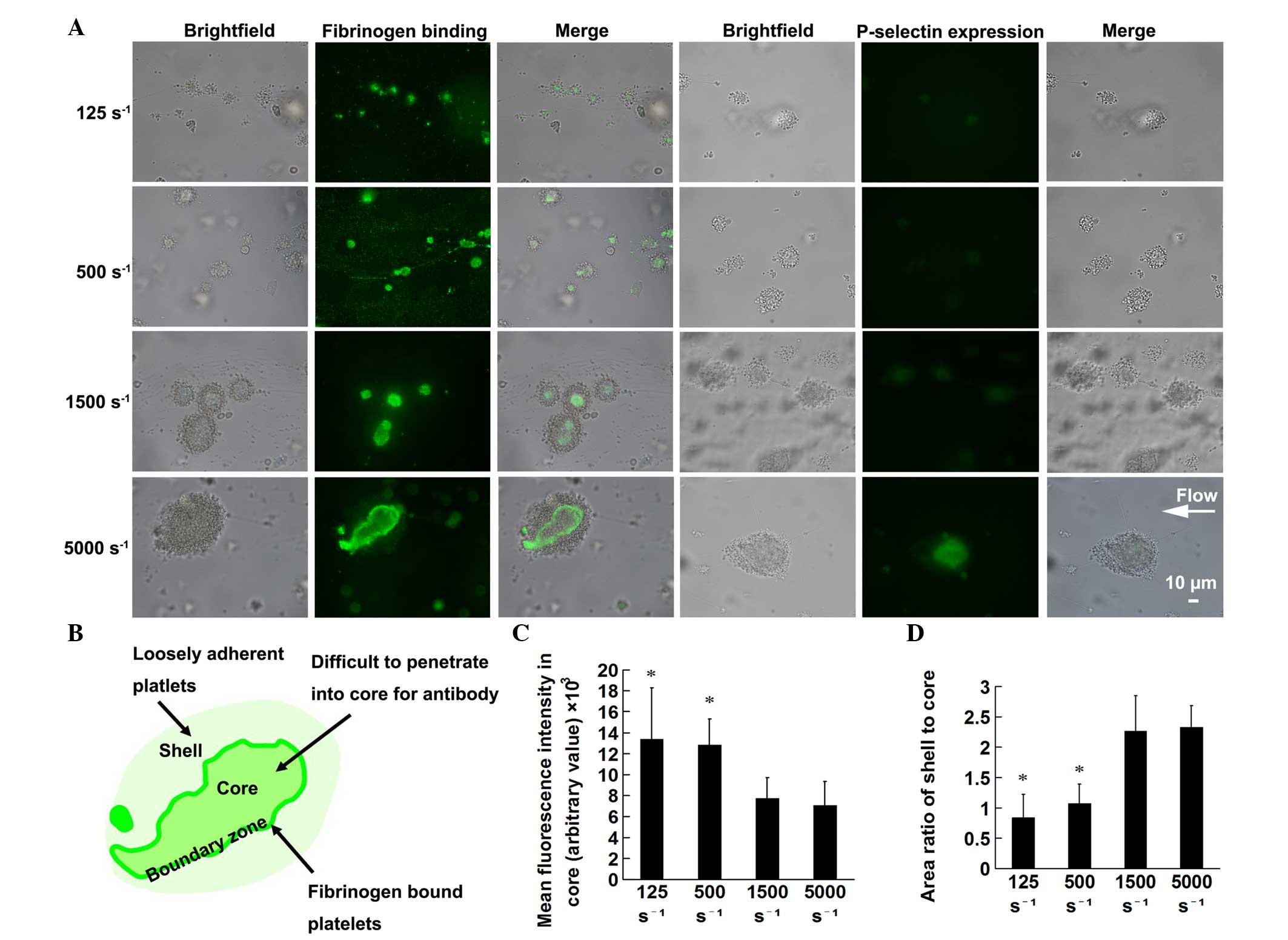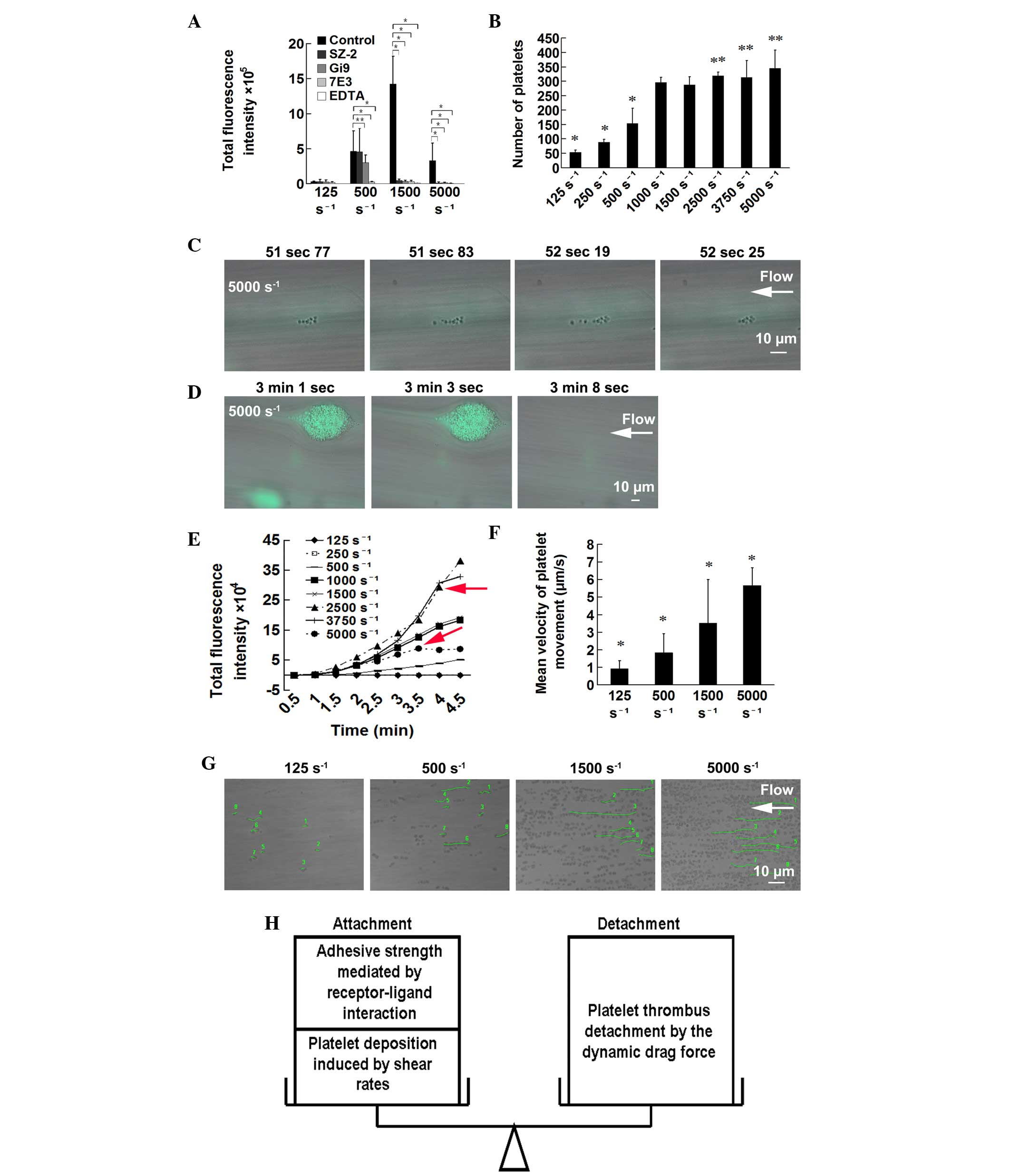|
1
|
Ruggeri ZM: Platelets in atherothrombosis.
Nat Med. 8:1227–1234. 2002. View Article : Google Scholar : PubMed/NCBI
|
|
2
|
Ruggeri ZM, Orje JN, Habermann R, Federici
AB and Reininger AJ: Activation-independent platelet adhesion and
aggregation under elevated shear stress. Blood. 108:1903–1910.
2006. View Article : Google Scholar : PubMed/NCBI
|
|
3
|
Kroll MH, Hellums JD, McIntire LV, Schafer
AI and Moake JL: Platelets and shear stress. Blood. 88:1525–1541.
1996.PubMed/NCBI
|
|
4
|
Colace TV, Tormoen GW, McCarty OJ and
Diamond SL: Microfluidics and coagulation biology. Annu Rev Biomed
Eng. 15:283–303. 2013. View Article : Google Scholar : PubMed/NCBI
|
|
5
|
Feghhi S and Sniadecki NJ: Mechanobiology
of platelets: Techniques to study the role of fluid flow and
platelet retraction forces at the micro- and nano-scale. Int J Mol
Sci. 12:9009–9030. 2011. View Article : Google Scholar
|
|
6
|
Savage B, Almus-Jacobs F and Ruggeri ZM:
Specific synergy of multiple substrate-receptor interactions in
platelet thrombus formation under flow. Cell. 94:657–666. 1998.
View Article : Google Scholar : PubMed/NCBI
|
|
7
|
Savage B, Saldivar E and Ruggeri ZM:
Initiation of platelet adhesion by arrest onto fibrinogen or
translocation on von Willebrand factor. Cell. 84:289–297. 1996.
View Article : Google Scholar : PubMed/NCBI
|
|
8
|
Inoue O, Suzuki-Inoue K and Ozaki Y:
Redundant mechanism of platelet adhesion to laminin and collagen
under flow: Involvement of von Willebrand factor and glycoprotein
Ib-IX-V. J Biol Chem. 283:16279–16282. 2008. View Article : Google Scholar : PubMed/NCBI
|
|
9
|
Watson SP: Platelet activation by
extracellular matrix proteins in haemostasis and thrombosis. Curr
Pharm Des. 15:1358–1372. 2009. View Article : Google Scholar : PubMed/NCBI
|
|
10
|
Farndale RW, Sixma JJ, Barnes MJ and de
Groot PG: The role of collagen in thrombosis and hemostasis. J
Thromb Haemost. 2:561–573. 2004. View Article : Google Scholar : PubMed/NCBI
|
|
11
|
Heemskerk JW, Sakariassen KS, Zwaginga JJ,
Brass LF, Jackson SP and Farndale RW: Collagen surfaces to measure
thrombus formation under flow: Possibilities for standardization. J
Thromb Haemost. 9:856–858. 2011. View Article : Google Scholar : PubMed/NCBI
|
|
12
|
Affeld K, Goubergrits L, Watanabe N and
Kertzscher U: Numerical and experimental evaluation of platelet
deposition to collagen coated surface at low shear rates. J
Biomech. 46:430–436. 2013. View Article : Google Scholar
|
|
13
|
Savage B, Ginsberg MH and Ruggeri ZM:
Influence of fibrillar collagen structure on the mechanisms of
platelet thrombus formation under flow. Blood. 94:2704–2715.
1999.PubMed/NCBI
|
|
14
|
Neeves KB, Onasoga AA, Hansen RR, Lilly
JJ, Venckunaite D, Sumner MB, Irish AT, Brodsky G, Manco-Johnson MJ
and Di Paola JA: Sources of variability in platelet accumulation on
type 1 fibrillar collagen in microfluidic flow assays. PLoS One.
8:e546802013. View Article : Google Scholar : PubMed/NCBI
|
|
15
|
Colace T, Falls E, Zheng XL and Diamond
SL: Analysis of morphology of platelet aggregates formed on
collagen under laminar blood flow. Ann Biomed Eng. 39:922–929.
2011. View Article : Google Scholar
|
|
16
|
Stephens G, He M, Wong C, Jurek M,
Luedemann HC, Shapurian G, Munnelly K, Muir C, Conley PB and
Phillips DR: Development of a perfusion chamber assay to study in
real time the kinetics of thrombosis and the antithrombotic
characteristics of antiplatelet drugs. Thromb J. 10:112012.
View Article : Google Scholar : PubMed/NCBI
|
|
17
|
Li M, Hotaling NA, Ku DN and Forest CR:
Microfluidic thrombosis under multiple shear rates and antiplatelet
therapy doses. PLoS One. 9:e824932014. View Article : Google Scholar : PubMed/NCBI
|
|
18
|
Westein E, van der Meer AD, Kuijpers MJ,
Frimat JP, van den Berg A and Heemskerk JW: Atherosclerotic
geometries exacerbate pathological thrombus formation poststenosis
in a von Willebrand factor-dependent manner. Proc Natl Acad Sci
USA. 110:1357–1362. 2013. View Article : Google Scholar : PubMed/NCBI
|
|
19
|
de Witt SM, Swieringa F, Cavill R, Lamers
MM, van Kruchten R, Mastenbroek T, Baaten C, Coort S, Pugh N,
Schulz A, et al: Identification of platelet function defects by
multi-parameter assessment of thrombus formation. Nat Commun.
5:42572014. View Article : Google Scholar : PubMed/NCBI
|
|
20
|
Stalker TJ, Traxler EA, Wu J, Wannemacher
KM, Cermignano SL, Voronov R, Diamond SL and Brass LF: Hierarchical
organization in the hemostatic response and its relationship to the
platelet-signaling network. Blood. 121:1875–1885. 2013. View Article : Google Scholar : PubMed/NCBI
|
|
21
|
Welsh JD, Stalker TJ, Voronov R, Muthard
RW, Tomaiuolo M, Diamond SL and Brass LF: A systems approach to
hemostasis: 1. The interdependence of thrombus architecture and
agonist movements in the gaps between platelets. Blood.
124:1808–1815. 2014. View Article : Google Scholar : PubMed/NCBI
|
|
22
|
Stalker TJ, Welsh JD, Tomaiuolo M, Wu J,
Colace TV, Diamond SL and Brass LF: A systems approach to
hemostasis: 3. Thrombus consolidation regulates intrathrombus
solute transport and local thrombin activity. Blood. 124:1824–1831.
2014. View Article : Google Scholar : PubMed/NCBI
|
|
23
|
Tomaiuolo M, Stalker TJ, Welsh JD, Diamond
SL, Sinno T and Brass LF: A systems approach to hemostasis: 2.
Computational analysis of molecular transport in the thrombus
microenvironment. Blood. 124:1816–1823. 2014. View Article : Google Scholar : PubMed/NCBI
|
|
24
|
Conant CG, Schwartz MA and Ionescu-Zanetti
C: Well plate-coupled microfluidic devices designed for facile
image-based cell adhesion and transmigration assays. J Biomol
Screen. 15:102–106. 2010. View Article : Google Scholar
|
|
25
|
Benoit MR, Conant CG, Ionescu-Zanetti C,
Schwartz M and Matin A: New device for high-throughput viability
screening of flow biofilms. Appl Environ Microbiol. 76:4136–4142.
2010. View Article : Google Scholar : PubMed/NCBI
|
|
26
|
Valéra MC, Gratacap MP, Gourdy P, Lenfant
F, Cabou C, Toutain CE, Marcellin M, Saint Laurent N, Sié P and
Sixou M: Chronic estradiol treatment reduces platelet responses and
protects mice from thromboembolism through the hematopoietic
estrogen receptor α. Blood. 120:1703–1712. 2012. View Article : Google Scholar
|
|
27
|
Ono A, Westein E, Hsiao S, Nesbitt WS,
Hamilton JR, Schoenwaelder SM and Jackson SP: Identification of a
fibrin-independent platelet contractile mechanism regulating
primary hemostasis and thrombus growth. Blood. 112:90–99. 2008.
View Article : Google Scholar : PubMed/NCBI
|
|
28
|
Reininger AJ, Heijnen HF, Schumann H,
Specht HM, Schramm W and Ruggeri ZM: Mechanism of platelet adhesion
to von Willebrand factor and microparticle formation under high
shear stress. Blood. 107:3537–3545. 2006. View Article : Google Scholar : PubMed/NCBI
|
|
29
|
Bao J, Xiao J, Mao Y and Zheng XL:
Carboxyl terminus of ADAMTS13 directly inhibits platelet
aggregation and ultra large von Willebrand factor string formation
under flow in a free-thiol-dependent manner. Arterioscler Thromb
Vasc Biol. 34:397–407. 2014. View Article : Google Scholar :
|
|
30
|
Conant CG, Schwartz MA, Beecher JE, Rudoff
RC, Ionescu-Zanetti C and Nevill JT: Well plate microfluidic system
for investigation of dynamic platelet behavior under variable shear
loads. Biotechnol Bioeng. 108:2978–2987. 2011. View Article : Google Scholar : PubMed/NCBI
|
|
31
|
Hathcock JJ: Flow effects on coagulation
and thrombosis. Arterioscler Thromb Vasc Biol. 26:1729–1737. 2006.
View Article : Google Scholar : PubMed/NCBI
|
|
32
|
Strony J, Beaudoin A, Brands D and Adelman
B: Analysis of shear stress and hemodynamic factors in a model of
coronary artery stenosis and thrombosis. Am J Physiol.
265:H1787–H1796. 1993.PubMed/NCBI
|
|
33
|
Nesbitt WS, Westein E, Tovar-Lopez FJ,
Tolouei E, Mitchell A, Fu J, Carberry J, Fouras A and Jackson SP: A
shear gradient-dependent platelet aggregation mechanism drives
thrombus formation. Nat Med. 15:665–673. 2009. View Article : Google Scholar : PubMed/NCBI
|
|
34
|
Wong AK: Platelet biology: The role of
shear. Expert Rev Hematol. 6:205–212. 2013. View Article : Google Scholar : PubMed/NCBI
|
|
35
|
Aleman MM, Byrnes JR, Wang JG, Tran R, Lam
WA, Di Paola J, Mackman N, Degen JL, Flick MJ and Wolberg A: Factor
XIII activity mediates red blood cell retention in venous thrombi.
J Clin Invest. 124:3590–3600. 2014. View Article : Google Scholar : PubMed/NCBI
|
|
36
|
Maxwell MJ, Westein E, Nesbitt WS,
Giuliano S, Dopheide SM and Jackson SP: Identification of a 2-stage
platelet aggregation process mediating shear-dependent thrombus
formation. Blood. 109:566–576. 2007. View Article : Google Scholar
|
|
37
|
Huang PY and Hellums JD: Aggregation and
disaggregation kinetics of human blood platelets: Part II.
Shear-induced platelet aggregation. Biophys J. 65:344–353. 1993.
View Article : Google Scholar : PubMed/NCBI
|
|
38
|
Wootton DM and Ku DN: Fluid mechanics of
vascular systems, diseases and thrombosis. Annu Rev Biomed Eng.
1:299–329. 1999. View Article : Google Scholar
|
|
39
|
Basmadjian D: Embolization: Critical
thrombus height, shear rates and pulsatility. Patency of blood
vessels. J Biomed Mater Res. 23:1315–1326. 1989. View Article : Google Scholar : PubMed/NCBI
|



